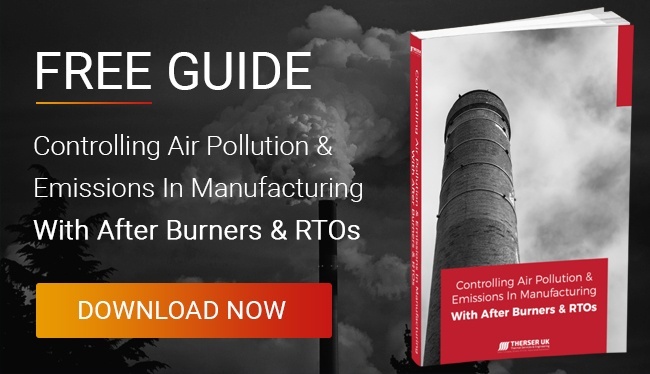Share this
How Does A Regenerative Thermal Oxidiser Work?
by Therser Sales Team on 20-Dec-2017 11:30:00

Regenerative thermal oxidisers (RTOs) have a unique ability to reuse the thermal energy derived from their operation, ensuring continuity and cutting fuel expenditure. This is one of the major advantages of using an RTO, making it suitable for many energy intensive industries.
But how does an RTO system work? There are four broad steps in the process, which are described below:
Step 1: Initial Heating
Here the regenerative thermal oxidiser unit is heated to combustion temperature using a supplementary fuel source. The fuel source could be diesel or bio-fuel, but propane and natural gas are more commonly used because of their low cost.
Between the initiation of the process (i.e., when heating starts) to the combustion temperature, the RTO system is first cleansed (purged) with fresh air. This continues until the combustion temperature equilibrium is reached. This final temperature is usually within the range of 815°C to 950°C, although heating is sometimes completed in stages to incorporate a pre-treatment stage.
Step 2: Pre-Treatment
Once the desired temperature is reached (around 700*C), the exhaust gas containing VOCs and some other hazardous pollutants are allowed to pass through a specialised thermal ceramic chamber within the first heat exchanger in the RTO unit. This strips out some of the most volatile components.
Step 3: Incineration Of Airborne Contaminants
Once the full combustion temperature is reached, the RTO unit is fed with the pre-treated exhaust air, which contains heavier VOC, metallic compounds and hazardous air pollutants (HAP) to be destroyed. The efficiency of the incineration phase may range from 85-99%.
Step 4: Heat Recovery
The effluent heat generated from incineration is consequently repurposed to operate and sustain combustion temperatures so that there’s no need for additional fuel. In practice, this means that some exhaust runs with a low contaminant levels can be successfully cleansed without the RTO requiring any external power. Recovered heat can also be directed to other systems, either industrial furnaces or kilns, or even to climate control or water heating systems.

Adopting An Appropriate Clean Air Strategy
Regenerative Thermal Oxidisers are one among a number of options available to manufacturers to improve air quality and reduce energy waste. Different manufacturers adopt various solutions on their own or in combination, depending on their business goals, compliance requirements and budget.
RTO’s are discussed in further detail in our e-book: Controlling Air Pollution & Emissions In Manufacturing With After burners & RTO’s, which also explains afterburners, filters and other clean air measures. Download a copy for free by clicking here.
Share this
- Company News (90)
- Battery Materials (41)
- kiln (37)
- fabrication (29)
- Alloy (27)
- Furnace (27)
- Welding (16)
- Industrial Kilns (15)
- Battery (13)
- Ceramic Kilns (13)
- Processes (13)
- alloy fabrication (13)
- Shuttle Kilns (12)
- RTO’s (11)
- Vacancies (11)
- Hydrogen (10)
- Therser UK (9)
- Tunnel Kiln (9)
- Refractory (8)
- Therser (8)
- Wellman Furnaces (8)
- Brickwork (7)
- Case Studies (7)
- Afterburners (6)
- Fibre Lining (6)
- electric (6)
- Almor Wellman (5)
- thermal engineers (5)
- Biochar (4)
- Exhibition (4)
- Pyrolysis (4)
- Servicing (4)
- Spares (4)
- heat treatment (4)
- History (3)
- Ceramics Uk (2)
- Combustion Control Upgrades (2)
- Nitrogen (2)
- Temperature Control Rings (2)
- gas (2)
- Certificates (1)
- Instrumentation (1)
- MMC (1)
- RHK (1)
- Roller Hearth Kiln (1)
- Test Trials (1)
- aerospace (1)
- analyser (1)
- elec (1)
- oxygen (1)
- vans (1)
- September 2025 (2)
- May 2025 (2)
- March 2025 (1)
- February 2025 (2)
- January 2025 (5)
- December 2024 (5)
- November 2024 (7)
- October 2024 (5)
- September 2024 (4)
- August 2024 (14)
- July 2024 (13)
- June 2024 (2)
- May 2024 (5)
- April 2024 (13)
- March 2024 (8)
- February 2024 (12)
- January 2024 (14)
- December 2023 (6)
- November 2023 (12)
- October 2023 (24)
- September 2023 (11)
- August 2023 (11)
- July 2023 (9)
- June 2023 (15)
- May 2023 (53)
- April 2023 (5)
- March 2023 (6)
- February 2023 (7)
- January 2023 (3)
- December 2022 (8)
- November 2022 (5)
- October 2022 (11)
- September 2022 (1)
- August 2022 (2)
- July 2022 (1)
- June 2022 (2)
- May 2022 (1)
- March 2022 (1)
- February 2022 (1)
- January 2022 (1)
- December 2021 (3)
- October 2021 (1)
- August 2021 (1)
- June 2021 (1)
- May 2021 (4)
- April 2021 (2)
- March 2021 (4)
- February 2021 (2)
- December 2020 (3)
- November 2020 (1)
- September 2020 (3)
- May 2020 (1)
- April 2020 (2)
- March 2020 (1)
- January 2020 (1)
- December 2019 (1)
- July 2019 (2)
- June 2019 (1)
- April 2019 (2)
- March 2019 (3)
- February 2019 (4)
- December 2018 (1)
- November 2018 (1)
- September 2018 (2)
- August 2018 (1)
- July 2018 (1)
- May 2018 (3)
- April 2018 (1)
- February 2018 (3)
- January 2018 (2)
- December 2017 (3)
- November 2017 (1)
- October 2017 (2)
- September 2017 (4)
- August 2017 (1)
- July 2017 (2)
- June 2017 (2)
- May 2017 (3)
- April 2017 (3)


